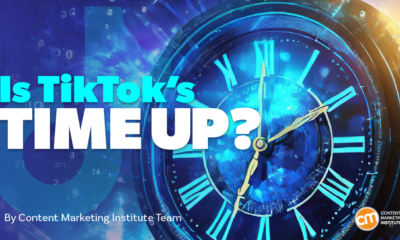MARKETING
16 of the Best Job Interview Questions to Ask Candidates (And What to Look for in Their Answers)

When you’re interviewing people to join your team, you have to get creative — after all, there’s only so much that questions like “What’s your biggest weakness?” and “Are you a team player?” reveal about who your candidates truly are.
But what are the best interview questions to ask that will help you uncover your candidate’s strengths, weaknesses, and interests?
To help give you some ideas for the next time you’re meeting with a job candidate, here are some of the best job interview questions to ask, plus good answers to each question.
Good Interview Questions
- What single project or task would you consider your most significant career accomplishment to date?
- Is it better to be perfect and late, or good and on time?
- Tell me about a time you screwed up.
- Tell me about a time you set difficult goals.
- What have you done professionally that is not an experience you’d want to repeat?
- What is your definition of hard work?
- Who is the smartest person you know personally? Why?
- What’s the biggest decision you’ve had to make in the past year? Why was it so big?
- Tell me about the relationships you’ve had with the people you’ve worked with. How would you describe the best ones? The worst?
- In five minutes, could you explain something to me that is complicated but you know well?
- If I were to poll everyone you’ve worked with, what percentage would not be a fan of yours?
- What is something you’d be happy doing every single day for the rest of your career?
- If you had $40,000 to build your own business, what would you do?
- Pitch our company to me as if I were buying our product/service.
- What has surprised you about this interview process so far?
- Do you have any questions for me?
Questions to Test a Candidate’s Honesty and Sense of Ownership
1. “What single project or task would you consider your most significant career accomplishment to date?”
Lou Adler, author of The Essential Guide for Hiring & Getting Hired and Hire With Your Head, spent 10 years searching for the single best interview question that will reveal whether to hire or not hire a candidate — and this was the one.
A good answer to this question:
Candidates’ answers will tell you about their prior success and sense of ownership. A great answer will show they are confident in their work and professional choices while being humble enough to show they care about the company’s success. For example, if a candidate built a sales or marketing campaign they’re particularly proud of, listen for them to explain how the business benefited from it. Did it help the company sign a major client?
2. “Is it better to be perfect and late, or good and on time?”
If your candidate responds with “It depends,” hear them out — the interview question itself is phrased in such a way that candidates can sense there is a right and wrong answer, and they’ll be looking for signs from you that they’re heading in the right direction.
A good answer to this question:
For most companies, the correct answer is “good and on time.” It’s important to let something be finished when it’s good enough. Let’s face it, every blog post, email, book, video, etc. can always be tweaked and improved. At some point, you’ve just got to ship it. Most managers don’t want someone who can’t hit deadlines because they’re paralyzed by perfection.
Try to remain neutral as they feel out their response, though. They might not be able to relate to work that’s measured purely by quality and deadline, but it’s important that they can express how they prioritize their tasks.
3. “Tell me about a time you screwed up.”
An oldie but goodie. This is a tried-and-true test for self-awareness. (Honestly, well-prepared candidates should see it coming and have an answer ready.) Someone who takes ownership of their mess-up and learns something from it is usually humble and mindful. Candidates who blame others or give a “fake” screw-up (something like “I worked too hard and burned out.”) are red flags.
A good answer to this question:
A good answer to this question will do two things well:
- Admit to a genuine mistake. Often candidates will dress up a mistake with a self-compliment or excuse to avoid looking weak. For example, “I was so committed to X that I overlooked Y.” On the contrary, good answers will just show that they miscalculated, plain and simple.
- Explain what they learned from it. It’s one thing to screw up, but it’s another thing to take that screw-up as an opportunity to improve. Great companies learn more from failure than they do from success — candidates who do too are exactly what you need to grow.
Questions to Test a Candidate’s Work Ethic
4. “Tell me about a time you set difficult goals.”
If you’re looking for a candidate who is goal-oriented and results-driven — as most hiring managers are — this question will help you gauge whether they’ll be able to handle the audacious goals you have in store for them. Ask follow-up questions like, “What did you do to achieve them?” Have the candidate walk you through the process and purpose of the goals they set out for themselves.
A good answer to this question:
A good answer to this interview question shows they understand what difficult goals are, and that they put a lot of effort into attaining their goals while maintaining a high standard of work quality. Listen for answers that describe a lofty goal and show why this goal challenged their normal targets. Responses that admit the candidate came up short of this goal can also indicate self-awareness and confidence despite a lack of success.
5. “What have you done professionally that is not an experience you’d want to repeat?”
A candidate’s answer to this question will give you an idea of how they viewed work they weren’t very happy with, which is bound to happen to everyone in every job at one point or another.
A good answer to this question:
HubSpot’s VP of Customer Service and Support Michael Redbord says candidates’ answers generally fall into a few categories:
- Something menial (e.g. envelope-stuffing). Pay attention to whether they understand the value of this getting done for the business, or whether they just think they’re too good for a job like that.
- Something really hard. Why was it hard? Was it because it was poorly planned, poorly executed, or something else? Where do they put the blame on it being such an unpleasant experience?
- Something team-related. Follow up with questions about the team, what their role on the team was, and so on.
Even the category of what they consider an experience they wouldn’t want to repeat is interesting, says Redbord. When you talk about extreme experiences that get people emotional, it can be very revealing. Keep in mind, however, that good answers don’t have to fall into any one category — what’s most important is if they extracted value from the experience despite their lack of interest in doing it again.
6. “What is your definition of hard work?”
Some organizations move at very different paces, and this question is an effective way to tell whether your candidate will be able to keep pace with the rest of your team and add value to your team. It also helps you identify someone who is a “hard worker in disguise,” meaning someone who might currently be at a slow-moving organization or in a role that is not well-suited to them, but wants to work somewhere where they can really get their hands dirty.
A good answer to this question:
A good answer doesn’t have to produce evidence of hard work — it should rather reveal if your candidate knows what it takes to get something done and solve the problems it was designed to solve.
Answers that talk about working hard by working smart are great, as well. Always listen for this — putting in the work to find the best way of doing something is often just as important as the task itself.
7. “Who is the smartest person you know personally? Why?”
These questions test what the candidate values and aspires to by forcing them to think of a real person they know, and then articulate what makes that person smart.
A good answer to this question:
Ideal answers vary, but could include specific examples of the person they’ve chosen’s ability to think ahead several steps and execute. They could also touch on the person’s decision-making skills, ability to connect, desire for learning, or application of the things they learned.
8. “What’s the biggest decision you’ve had to make in the past year? Why was it so big?”
Here’s a great way to figure out how a candidate approaches decision-making. Were they quick to make that big decision, or did it take them a long time? Did they spend most of their time reflecting on it by themselves or fleshing it out with others? How did they make a plan?
A good answer to this question:
Candidates’ answers could be work-related or personal. In addition to revealing their thought process, as described above, an effective response to this interview question will also show how the candidate was able to prioritize what was most important when each possible option might have had its own advantages and disadvantages.
If your candidate had hiring power in a previous position, for example, maybe they found it hard to choose between two job candidates of their own. A good answer might show that they saw immediate skill in one candidate but long-term potential in the other. Although both people had usable strengths, your candidate chose the second person because he or she offered he best return on investment.

Questions to Test a Candidate’s Interests, Passions, & Working Style
9. “Tell me about the relationships you’ve had with the people you’ve worked with. How would you describe the best ones? The worst?”
Each team is different, so this question helps you tease out whether the candidate would be happy, productive, and well liked on your team. Their answer will tell you how they interact with others — and which kinds of interactions they want to happen.
A good answer to this question:
Answers to this question don’t have to focus on just professional elements of a relationship with colleagues — they can also be related to business culture. Maybe the candidate enjoyed their coworker’s positivity or thought their attitude lowered morale. Good responses aren’t one-sided, though. Look for answers that explain how their colleague’s work style thrived (or conflicted) with their own — not simply what their colleague did that benefited or offended them.
Many candidates are hesitant to bad-mouth their coworkers and bosses, so it’ll be interesting for you to hear how they navigate a question about their worst working relationships.
10. “In five minutes, could you explain something to me that is complicated but you know well?”
This is a much better test of intelligence than a college GPA, and it’s also a great gauge of a candidate’s passion and charisma outside of their core job responsibilities. Candidates who are passionate and knowledgeable about something — and can convey that well — are more likely to be enthusiastic and influential at work.
A good answer to this question:
The “something” in this question doesn’t have to be work-related — it can be a hobby, a sports team, something technical … anything, really. Good responses will tell you how well your candidate comprehends complex subjects and that they can articulate that subject to someone who doesn’t know much about it.
Explanations that use analogies also make good answers, especially if it’s a topic that is filled with industry jargon. This shows that the candidate can solve problems by drawing comparisons to things that are more universally understood.
11. “If I were to poll everyone you’ve worked with, what percentage would not be a fan of yours?”
At work, you can’t please everyone all the time. The answer to this question will help you find out if your candidate has enough drive and conviction in their own work to have ever conflicted with one or more of their colleagues.
Obviously you don’t want the candidate to be an unlikable person, though, so consider asking follow-up questions to find out why they might have alienated these coworkers: “If I were to interview these people, what words would they most frequently use to describe you?”
A good answer to this question:
The follow-up question about word choice is more important than the percentage they give in the initial question. In their answers, you should be encouraged by words like “passionate” and concerned by words like “lazy.”
Of course, not all negative words are red flags — while words that indicate a lack of work ethic might be a bad sign, words like “stubborn” could show a candidate’s self-awareness — and commitment to things their coworkers would rather move on from.
12. “What is something you’d be happy doing every single day for the rest of your career?”
While it’s important to hire for skill, it’s also important to hire someone who’s likely to be happy in the job for which you’re hiring. A question like this one will help uncover what makes each candidate happy at work — which is a great way to gauge whether they’d enjoy their role and stay at the company for a long time.
A good answer to this question:
There’s no right answer to this question — it’s more of a learning opportunity for you to see what your employees most enjoy in the industry. Nonetheless, a candidate’s answer to this question should align with the core responsibilities of the job for which they’re applying.
A sales candidate who says they could lead client kickoff meetings every day, for example, is a much better fit than a sales candidate who prefers to create lead-generating campaigns (a task that shows a bigger interest in the marketing side of things).
13. “If you had $40,000 to build your own business, what would you do?”
This question is a favorite of HubSpot Marketing Team Development Manager Emily MacIntyre. First, the type of business they choose to talk about can reveal a lot about their interests, values, and how creative they are. Second, it’ll give you insight into how business-savvy they are. By giving them a specific amount to work with (in this case, $40,000), they have the opportunity to parse out how they’d spend that money.
A good answer to this question:
The best answers to this question will get specific: They’ll offer an overview of the business and get into the logistics of where that money would go, whom they’d hire first, and so on.
Questions to Test a Candidate’s Knowledge or Interest in Your Specific Company
14. “Pitch our company to me as if I were buying our product/service.”
This is a unique and more challenging approach to the generic “What does our company do?” question. It forces candidates to not only drum up the research they’ve done to prepare for the interview, but also show they can use this research to craft a persuasive message that would be valuable in a business situation.
A good answer to this question:
This will come more naturally to some candidates than others. Above all, good answers to this interview question are able to combine an accurate definition of your company with what it offers to your core customer that they need or can’t get anywhere else.
Keep in mind that someone interviewing for a sales or marketing position might find it easier than someone interviewing for a non-client facing role — and that’s okay. You aren’t necessarily assessing their delivery. But it’ll be interesting to see how each candidate thinks through and gives their response.
15. “What has surprised you about this interview process so far?”
This is a question no candidate can really prepare for, and it’ll give you some indication of how candidates are feeling about the whole thing. Plus, you can see how they think on their feet.
A good answer to this question:
You’re looking for specifics here — something about the office space; the personality of the team; an assignment they were given to complete.
Honest answers are good answers, and answers that are directed at you are even better, as they show the candidate is confident speaking their mind in front of decision-makers. For instance, maybe the candidate was surprised you asked them about something on their resume that they don’t personally pay much attention to.
16. “Do you have any questions for me?”
This is another classic interview question, and like the one above, you’re seeing how candidates think on their feet. The answer to this question also reveals what’s important to the candidate. Are they wondering about company culture, or compensation? Are they curious about growth potential, or learning opportunities?
A good answer to this question:
There are no right or wrong answers, but personality and communication style are important factors when considering hiring someone to join your team, and you can get a sense of these factors with their answer.
Source link
MARKETING
Tinuiti Marketing Analytics Recognized by Forrester

Rapid Media Mix Modeling and Proprietary Tech Transform Brand Performance
Tinuiti, the largest independent full-funnel performance marketing agency, has been included in a recent Forrester Research report titled, “The Marketing Analytics Landscape, Q2 2024.” This report comprehensively overviews marketing analytics markets, use cases, and capabilities. B2C marketing leaders can use this research by Principal Analyst Tina Moffett to understand the intersection of marketing analytics capabilities and use cases to determine the vendor or service provider best positioned for their analytics and insights needs. Moffett describes the top marketing analytics markets as advertising agencies, marketing dashboards and business intelligence tools, marketing measurement and optimization platforms and service providers, and media analytics tools.
As an advertising agency, we believe Tinuiti is uniquely positioned to manage advertising campaigns for brands including buying, targeting, and measurement. Our proprietary measurement technology, Bliss Point by Tinuiti, allows us to measure the optimal level of investment to maximize impact and efficiency. According to the Forrester report, “only 30% of B2C marketing decision-makers say their organization uses marketing or media mix modeling (MMM),” so having a partner that knows, embraces, and utilizes MMM is important. As Tina astutely explains, data-driven agencies have amplified their marketing analytics competencies with data science expertise; and proprietary tools; and tailored their marketing analytics techniques based on industry, business, and data challenges.
Our Rapid Media Mix Modeling sets a new standard in the market with its exceptional speed, precision, and transparency. Our patented tech includes Rapid Media Mix Modeling, Always-on Incrementality, Brand Equity, Creative Insights, and Forecasting – it will get you to your Marketing Bliss Point in each channel, across your entire media mix, and your overall brand performance.
As a marketing leader you may ask yourself:
- How much of our marketing budget should we allocate to driving store traffic versus e-commerce traffic?
- How should we allocate our budget by channel to generate the most traffic and revenue possible?
- How many customers did we acquire in a specific region with our media spend?
- What is the impact of seasonality on our media mix?
- How should we adjust our budget accordingly?
- What is the optimal marketing channel mix to maximize brand awareness?
These are just a few of the questions that Bliss Point by Tinuiti can help you answer.
Learn more about our customer-obsessed, product-enabled, and fully integrated approach and how we’ve helped fuel full-funnel outcomes for the world’s most digital-forward brands like Poppi & Toms.
The Landscape report is available online to Forrester customers or for purchase here.
MARKETING
Ecommerce evolution: Blurring the lines between B2B and B2C

Understanding convergence
B2B and B2C ecommerce are two distinct models of online selling. B2B ecommerce is between businesses, such as wholesalers, distributors, and manufacturers. B2C ecommerce refers to transactions between businesses like retailers and consumer brands, directly to individual shoppers.
However, in recent years, the boundaries between these two models have started to fade. This is known as the convergence between B2B and B2C ecommerce and how they are becoming more similar and integrated.
Source: White Paper: The evolution of the B2B Consumer Buyer (ClientPoint, Jan 2024)
What’s driving this change?
Ever increasing customer expectations
Customers today expect the same level of convenience, speed, and personalization in their B2B transactions as they do in their B2C interactions. B2B buyers are increasingly influenced by their B2C experiences. They want research, compare, and purchase products online, seamlessly transitioning between devices and channels. They also prefer to research and purchase online, using multiple devices and channels.
Forrester, 68% of buyers prefer to research on their own, online . Customers today expect the same level of convenience, speed, and personalization in their B2B transactions as they do in their B2C interactions. B2B buyers are increasingly influenced by their B2C experiences. They want research, compare, and purchase products online, seamlessly transitioning between devices and channels. They also prefer to research and purchase online, using multiple devices and channels
Technology and omnichannel strategies
Technology enables B2B and B2C ecommerce platforms to offer more features and functionalities, such as mobile optimization, chatbots, AI, and augmented reality. Omnichannel strategies allow B2B and B2C ecommerce businesses to provide a seamless and consistent customer experience across different touchpoints, such as websites, social media, email, and physical stores.
However, with every great leap forward comes its own set of challenges. The convergence of B2B and B2C markets means increased competition. Businesses now not only have to compete with their traditional rivals, but also with new entrants and disruptors from different sectors. For example, Amazon Business, a B2B ecommerce platform, has become a major threat to many B2B ecommerce businesses, as it offers a wide range of products, low prices, and fast delivery
“Amazon Business has proven that B2B ecommerce can leverage popular B2C-like functionality” argues Joe Albrecht, CEO / Managing Partner, Xngage. . With features like Subscribe-and-Save (auto-replenishment), one-click buying, and curated assortments by job role or work location, they make it easy for B2B buyers to go to their website and never leave. Plus, with exceptional customer service and promotional incentives like Amazon Business Prime Days, they have created a reinforcing loyalty loop.
And yet, according to Barron’s, Amazon Business is only expected to capture 1.5% of the $5.7 Trillion addressable business market by 2025. If other B2B companies can truly become digital-first organizations, they can compete and win in this fragmented space, too.”
If other B2B companies can truly become digital-first organizations, they can also compete and win in this fragmented space
Joe AlbrechtCEO/Managing Partner, XNGAGE
Increasing complexity
Another challenge is the increased complexity and cost of managing a converging ecommerce business. Businesses have to deal with different customer segments, requirements, and expectations, which may require different strategies, processes, and systems. For instance, B2B ecommerce businesses may have to handle more complex transactions, such as bulk orders, contract negotiations, and invoicing, while B2C ecommerce businesses may have to handle more customer service, returns, and loyalty programs. Moreover, B2B and B2C ecommerce businesses must invest in technology and infrastructure to support their convergence efforts, which may increase their operational and maintenance costs.
How to win
Here are a few ways companies can get ahead of the game:
Adopt B2C-like features in B2B platforms
User-friendly design, easy navigation, product reviews, personalization, recommendations, and ratings can help B2B ecommerce businesses to attract and retain more customers, as well as to increase their conversion and retention rates.
According to McKinsey, ecommerce businesses that offer B2C-like features like personalization can increase their revenues by 15% and reduce their costs by 20%. You can do this through personalization of your website with tools like Product Recommendations that help suggest related products to increase sales.
Focus on personalization and customer experience
B2B and B2C ecommerce businesses need to understand their customers’ needs, preferences, and behaviors, and tailor their offerings and interactions accordingly. Personalization and customer experience can help B2B and B2C ecommerce businesses to increase customer satisfaction, loyalty, and advocacy, as well as to improve their brand reputation and competitive advantage. According to a Salesforce report, 88% of customers say that the experience a company provides is as important as its products or services.
Market based on customer insights
Data and analytics can help B2B and B2C ecommerce businesses to gain insights into their customers, markets, competitors, and performance, and to optimize their strategies and operations accordingly. Data and analytics can also help B2B and B2C ecommerce businesses to identify new opportunities, trends, and innovations, and to anticipate and respond to customer needs and expectations. According to McKinsey, data-driven organizations are 23 times more likely to acquire customers, six times more likely to retain customers, and 19 times more likely to be profitable.
What’s next?
The convergence of B2B and B2C ecommerce is not a temporary phenomenon, but a long-term trend that will continue to shape the future of ecommerce. According to Statista, the global B2B ecommerce market is expected to reach $20.9 trillion by 2027, surpassing the B2C ecommerce market, which is expected to reach $10.5 trillion by 2027. Moreover, the report predicts that the convergence of B2B and B2C ecommerce will create new business models, such as B2B2C, B2A (business to anyone), and C2B (consumer to business).
Therefore, B2B and B2C ecommerce businesses need to prepare for the converging ecommerce landscape and take advantage of the opportunities and challenges it presents. Here are some recommendations for B2B and B2C ecommerce businesses to navigate the converging landscape:
- Conduct a thorough analysis of your customers, competitors, and market, and identify the gaps and opportunities for convergence.
- Develop a clear vision and strategy for convergence, and align your goals, objectives, and metrics with it.
- Invest in technology and infrastructure that can support your convergence efforts, such as cloud, mobile, AI, and omnichannel platforms.
- Implement B2C-like features in your B2B platforms, and vice versa, to enhance your customer experience and satisfaction.
- Personalize your offerings and interactions with your customers, and provide them with relevant and valuable content and solutions.
- Leverage data and analytics to optimize your performance and decision making, and to innovate and differentiate your business.
- Collaborate and partner with other B2B and B2C ecommerce businesses, as well as with other stakeholders, such as suppliers, distributors, and customers, to create value and synergy.
- Monitor and evaluate your convergence efforts, and adapt and improve them as needed.
By following these recommendations, B2B and B2C ecommerce businesses can bridge the gap between their models and create a more integrated and seamless ecommerce experience for their customers and themselves.
MARKETING
Streamlining Processes for Increased Efficiency and Results

How can businesses succeed nowadays when technology rules? With competition getting tougher and customers changing their preferences often, it’s a challenge. But using marketing automation can help make things easier and get better results. And in the future, it’s going to be even more important for all kinds of businesses.
So, let’s discuss how businesses can leverage marketing automation to stay ahead and thrive.
Benefits of automation marketing automation to boost your efforts
First, let’s explore the benefits of marketing automation to supercharge your efforts:
Marketing automation simplifies repetitive tasks, saving time and effort.
With automated workflows, processes become more efficient, leading to better productivity. For instance, automation not only streamlines tasks like email campaigns but also optimizes website speed, ensuring a seamless user experience. A faster website not only enhances customer satisfaction but also positively impacts search engine rankings, driving more organic traffic and ultimately boosting conversions.
Automation allows for precise targeting, reaching the right audience with personalized messages.
With automated workflows, processes become more efficient, leading to better productivity. A great example of automated workflow is Pipedrive & WhatsApp Integration in which an automated welcome message pops up on their WhatsApp
within seconds once a potential customer expresses interest in your business.
Increases ROI
By optimizing campaigns and reducing manual labor, automation can significantly improve return on investment.
Leveraging automation enables businesses to scale their marketing efforts effectively, driving growth and success. Additionally, incorporating lead scoring into automated marketing processes can streamline the identification of high-potential prospects, further optimizing resource allocation and maximizing conversion rates.
Harnessing the power of marketing automation can revolutionize your marketing strategy, leading to increased efficiency, higher returns, and sustainable growth in today’s competitive market. So, why wait? Start automating your marketing efforts today and propel your business to new heights, moreover if you have just learned ways on how to create an online business
How marketing automation can simplify operations and increase efficiency
Understanding the Change
Marketing automation has evolved significantly over time, from basic email marketing campaigns to sophisticated platforms that can manage entire marketing strategies. This progress has been fueled by advances in technology, particularly artificial intelligence (AI) and machine learning, making automation smarter and more adaptable.
One of the main reasons for this shift is the vast amount of data available to marketers today. From understanding customer demographics to analyzing behavior, the sheer volume of data is staggering. Marketing automation platforms use this data to create highly personalized and targeted campaigns, allowing businesses to connect with their audience on a deeper level.
The Emergence of AI-Powered Automation
In the future, AI-powered automation will play an even bigger role in marketing strategies. AI algorithms can analyze huge amounts of data in real-time, helping marketers identify trends, predict consumer behavior, and optimize campaigns as they go. This agility and responsiveness are crucial in today’s fast-moving digital world, where opportunities come and go in the blink of an eye. For example, we’re witnessing the rise of AI-based tools from AI website builders, to AI logo generators and even more, showing that we’re competing with time and efficiency.
Combining AI-powered automation with WordPress management services streamlines marketing efforts, enabling quick adaptation to changing trends and efficient management of online presence.
Moreover, AI can take care of routine tasks like content creation, scheduling, and testing, giving marketers more time to focus on strategic activities. By automating these repetitive tasks, businesses can work more efficiently, leading to better outcomes. AI can create social media ads tailored to specific demographics and preferences, ensuring that the content resonates with the target audience. With the help of an AI ad maker tool, businesses can efficiently produce high-quality advertisements that drive engagement and conversions across various social media platforms.
Personalization on a Large Scale
Personalization has always been important in marketing, and automation is making it possible on a larger scale. By using AI and machine learning, marketers can create tailored experiences for each customer based on their preferences, behaviors, and past interactions with the brand.
This level of personalization not only boosts customer satisfaction but also increases engagement and loyalty. When consumers feel understood and valued, they are more likely to become loyal customers and brand advocates. As automation technology continues to evolve, we can expect personalization to become even more advanced, enabling businesses to forge deeper connections with their audience. As your company has tiny homes for sale California, personalized experiences will ensure each customer finds their perfect fit, fostering lasting connections.
Integration Across Channels
Another trend shaping the future of marketing automation is the integration of multiple channels into a cohesive strategy. Today’s consumers interact with brands across various touchpoints, from social media and email to websites and mobile apps. Marketing automation platforms that can seamlessly integrate these channels and deliver consistent messaging will have a competitive edge. When creating a comparison website it’s important to ensure that the platform effectively aggregates data from diverse sources and presents it in a user-friendly manner, empowering consumers to make informed decisions.
Omni-channel integration not only betters the customer experience but also provides marketers with a comprehensive view of the customer journey. By tracking interactions across channels, businesses can gain valuable insights into how consumers engage with their brand, allowing them to refine their marketing strategies for maximum impact. Lastly, integrating SEO services into omni-channel strategies boosts visibility and helps businesses better understand and engage with their customers across different platforms.
The Human Element
While automation offers many benefits, it’s crucial not to overlook the human aspect of marketing. Despite advances in AI and machine learning, there are still elements of marketing that require human creativity, empathy, and strategic thinking.
Successful marketing automation strikes a balance between technology and human expertise. By using automation to handle routine tasks and data analysis, marketers can focus on what they do best – storytelling, building relationships, and driving innovation.
Conclusion
The future of marketing automation looks promising, offering improved efficiency and results for businesses of all sizes.
As AI continues to advance and consumer expectations change, automation will play an increasingly vital role in keeping businesses competitive.
By embracing automation technologies, marketers can simplify processes, deliver more personalized experiences, and ultimately, achieve their business goals more effectively than ever before.
-

 SEO7 days ago
SEO7 days agoGoogle Limits News Links In California Over Proposed ‘Link Tax’ Law
-

 SEARCHENGINES6 days ago
SEARCHENGINES6 days agoGoogle Core Update Volatility, Helpful Content Update Gone, Dangerous Google Search Results & Google Ads Confusion
-

 SEO6 days ago
SEO6 days ago10 Paid Search & PPC Planning Best Practices
-

 MARKETING7 days ago
MARKETING7 days ago2 Ways to Take Back the Power in Your Business: Part 2
-

 MARKETING5 days ago
MARKETING5 days ago5 Psychological Tactics to Write Better Emails
-

 SEARCHENGINES5 days ago
SEARCHENGINES5 days agoWeekend Google Core Ranking Volatility
-

 PPC7 days ago
PPC7 days agoCritical Display Error in Brand Safety Metrics On Twitter/X Corrected
-

 MARKETING6 days ago
MARKETING6 days agoThe power of program management in martech















You must be logged in to post a comment Login